Leitz 8x50 + "Binovista" 15x60
Hälften von DoppelfernrohrenDie hier gezeigten 15x60 und 8x50 Modelle von Leitz sind monokulare Hälften des "Binovista" Modells, das in einem 1930er Katalog als binokulares Aussichtsfernrohr geführt wird (s. Katalogausschnitt) bzw. der Doppelfernrohre für Scheinwerferrichtungsweiser und Signalgeräte (vgl. Seeger, Mil. Ferngläser ..., 2005, 3. Aufl., S. 174f.).Das vorliegende 15x60 Monokular ist mit "15 X L16 60 = 3,4°" beschriftet, womit die Vergrößerung, die Lichtstärke und das Gesichtsfeld in Metern und Grad angegeben wird. Die andere Tubushälfte mit "Leitz"-Kennzeichnung entspräche dem unten gezeigten 8x50 Hälfte. Die Hälfte des Fernglases wurde sehr gut am Stativadapter umgearbeitet (s. Fotos des Binokulars und Stativansatze). Das 15x60 kann mit einer Montierungsrohr an einem Stativzapfen festgezurrt werden. Der abgechrägte Ansatz des Stativadapters ist mit einer angeschraubten Messingplatte abgedeckt. Möglicherweise wurde das 15x60 so als monokulares Signalfernrohr noch genutzt (s. Angaben bei fernglas.at). |
Halves of a Double-TelescopesThe depcited 15x60 and 8x50 models by Leitz are monocular halves of the "Binovista" model, which is listed as a civilian look-out binocular in a 1930 catalogue (cf. catalogue clip), or the binoculars for searchlight directors and signalling devices (cf. Seeger, Mil. Binocualrs ..., 2005, 3. ed., p. 174f.).The first monocular here is marked "15 X L16 60 = 3,4°" which states its power, its brightness, and ist field of view in meters and degrees. The other tube half would come with he "Leitz" marking as seen on the 8x50 half below. The half was refurbished very smartly near the tripod adapter (cf. photos of the binocular and its tripod mount). The 15x60 can be clamped to a tripod pin with a mounting socket. The sloping mount of the adapter covered by a screwed-on brass palte. This way, the 15x60 may have still been used as a monocular signalling telescope (cf. at fernglas.at). |
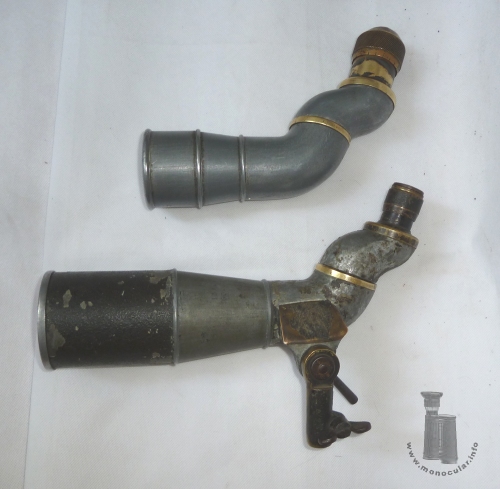
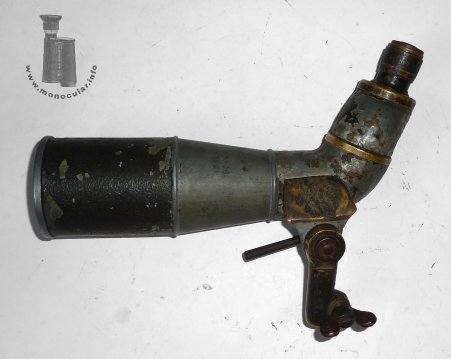
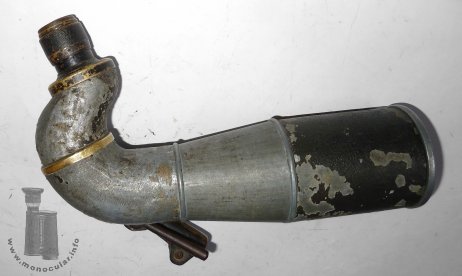
| Das Aluminiumgehäuse war mit einem schwarzen, strukturiertem Lack ummantelt. Das Okular hat eine umlaufende Dioptrienskala, die Beschriftungszahlen sind nicht mehr eindeutig erkennbar. Die Augenmuschel fehlt. Die Besonderheit dieses Leitz-Ferngalstyps besteht in einem rotierbarem Okulargehäusestück (Tilde-förmig ~), so dass in verschiedenen Positionen in einem ca. 80°-Winkel in das Fernrohr geschaut werden kann, was bei Beobachtungen gen Himmel oder geradeaus eine ermüdungsfreiere Kopfhaltung bewirkt. Bei dem binokularen Modell konnte der Augenabstand damit justiert werden. Die Strahlführung wurde durch ein Dachkant- und ein Rhombozidprisma realisiert (s. Teilefoto und Diagramm enes bau-ähnlichen Jap. Fernglases). | The aluminium body was lacquered with some textured black paint. The eyepiece has a full dioptre adjustment scale, but the marked numbers are barely visisble any more. The eyecup is missing. The special feature of those Leitz models is the rotatable eyepiece-section (tilde shaped ~) so that you can look through it in a approximately 80° angle the eyepiece positioned differentlly. This is a non-fatigue viewing position while observing towards the sky or straight ahead. This mechanism served to adjust eye distance on the binocular models. The light-path was guided by a roof prism and a rhombocide prism (cf. photo of the parts and the diagramme of Japanese binocular with a similar construction). |

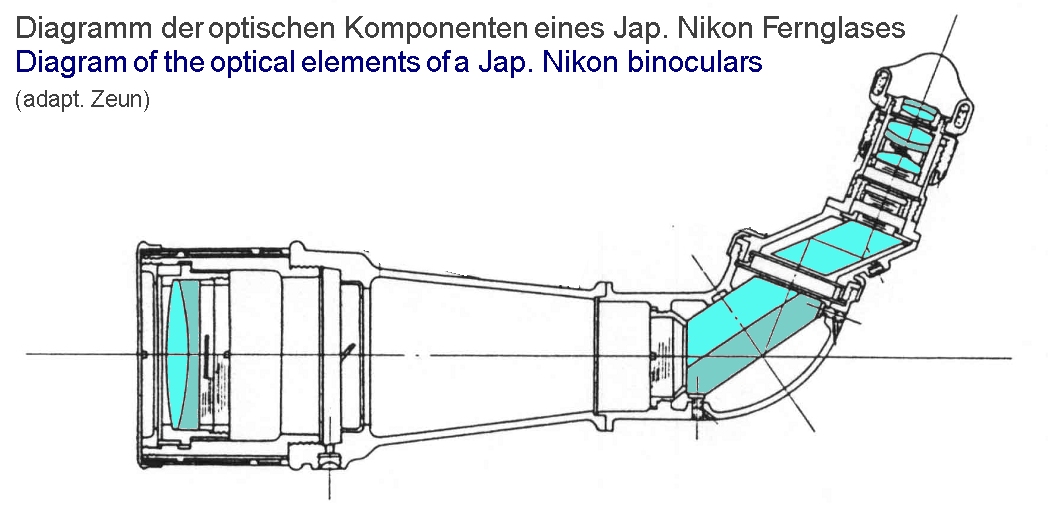
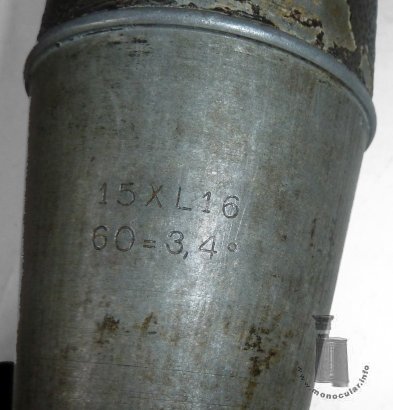
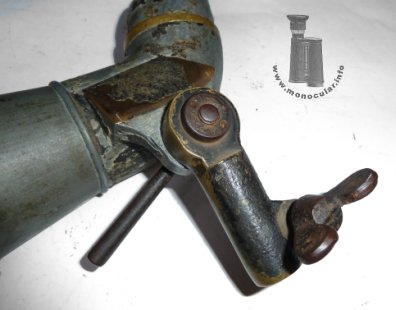

| Das Binovista-Monokular ist 26cm bzw. 30cm lang, je nach Okularposition. Der 97mm lange gerade Objektivtubus ist 73mm im Durchmesser, der 68mm lange konische Tubus verbreitert sich von 52mm auf 69mm im Durchmesser. Das geschwungene Prismengehäuse variiert zwischen 50 und 52mm im Durchmesser. Der Okular-Durchmesser ist 27mm bzw. 30mm beim Fokussierungsring. Das Monokular wiegt 1250g. Es ist auch bei fernglasmuseum.at beschrieben. |
The Binovista-Monocular is 26cm or 30cm lang depending on the eyepiece position. The 97mm long straight objective tube is 73mm in diameter, the 68mm long conical tube increases from 52mm to 59mm in diameter. The curved prism housing varies between 50 and 52mm in diameter. The diameter of the eyepiece is 27mm or 30mm at the focussing ring respectively. The monocular weighs 1250g. It is also described at fernglasmuseum.at). |

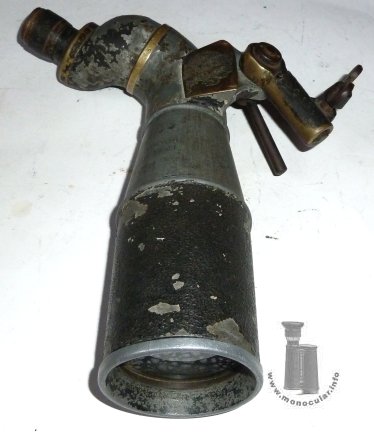
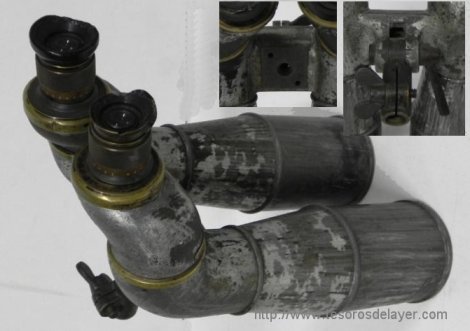
| Das halbe 8x50 stellt im Grunde die anderen, aber kleinere Hälfte der oberen 15x60 Hälfte dar; es hat eine Skala für die Augenabstandseisntellung und die Beschriftung "E. Leitz Wetzlar No 90166". Das Monokular ist 17-22cm lang je nach Okularstellung. Das drehbare und die geschwungenen Prismengehäuse sind identisch zum größeren 15x60. Der nur 33mm lange konische Tubus verbreitert sich von 51 auf 58mm im Durchmesser. Der 37mm lange gerade Objektivtubus ist 60mm im Durchmesser. Das Okularstück ist 37mm bzw. 45mm am Fokussierungsring im Durchmesser. Das Mono wiegt 855g. | The 8x50 half is basically the opposite half of the 15x60 half shown above; it has a interpupillary distance scale, and is marked "E. Leitz Wetzlar No 90166". The monocular is 17-22cm long depending on eyepiece position. The rotatable and curved prism housings are identical to the bigger 15x60. The jsut 33mm long conical tube increases from 51 to 58mm in diameter. The 37mm long straight objective tube is 60mm in diameter. The eyepiece is 37mm and 45mm at its focusing ring in diameter. The monocular weighs 855g. |


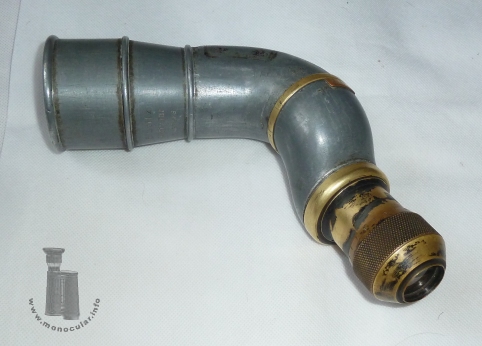
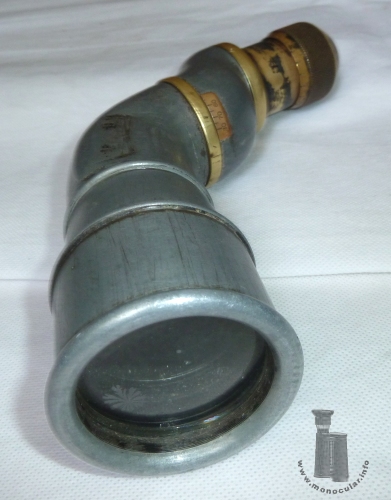
Fotos: Zeun; 5 Internet

